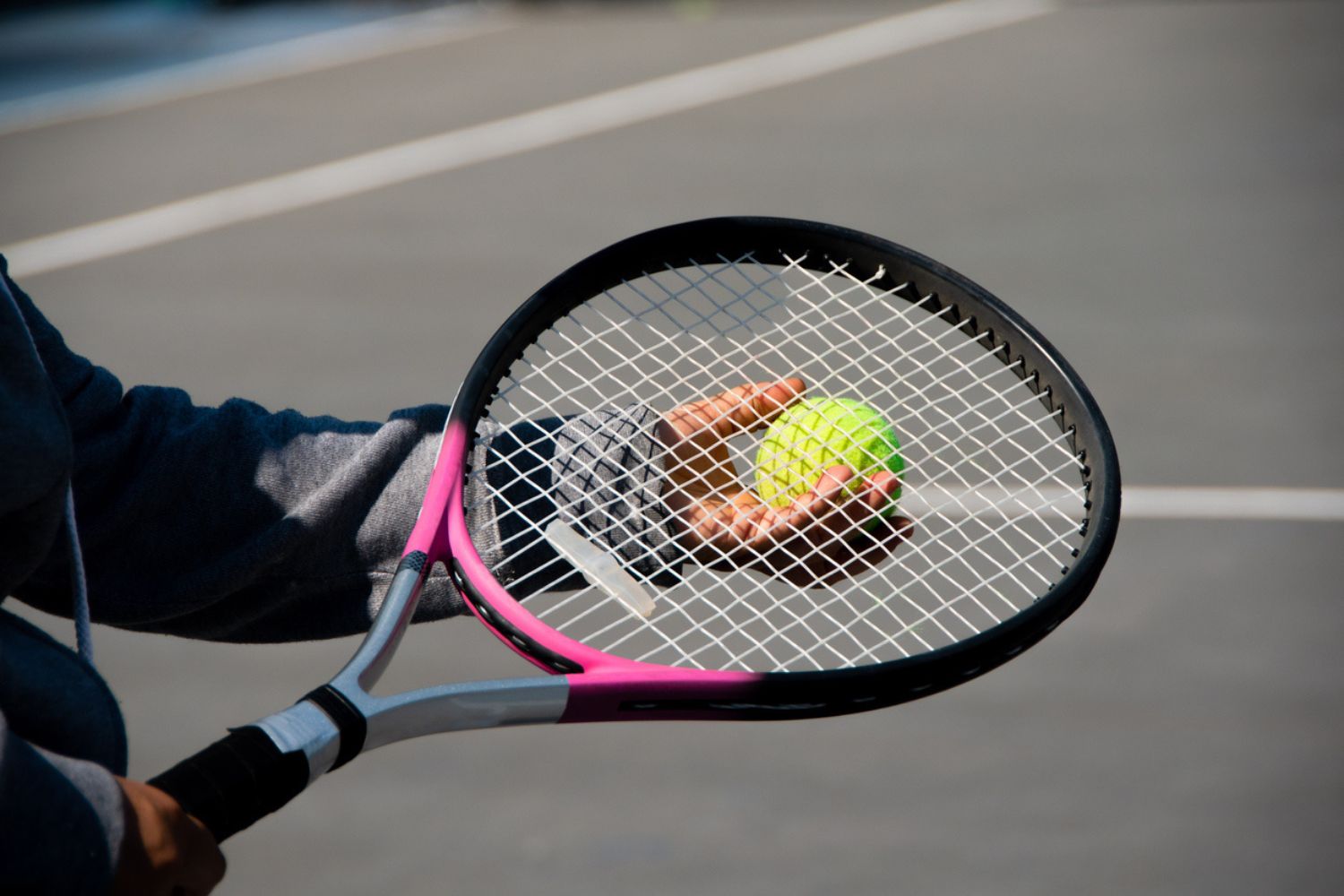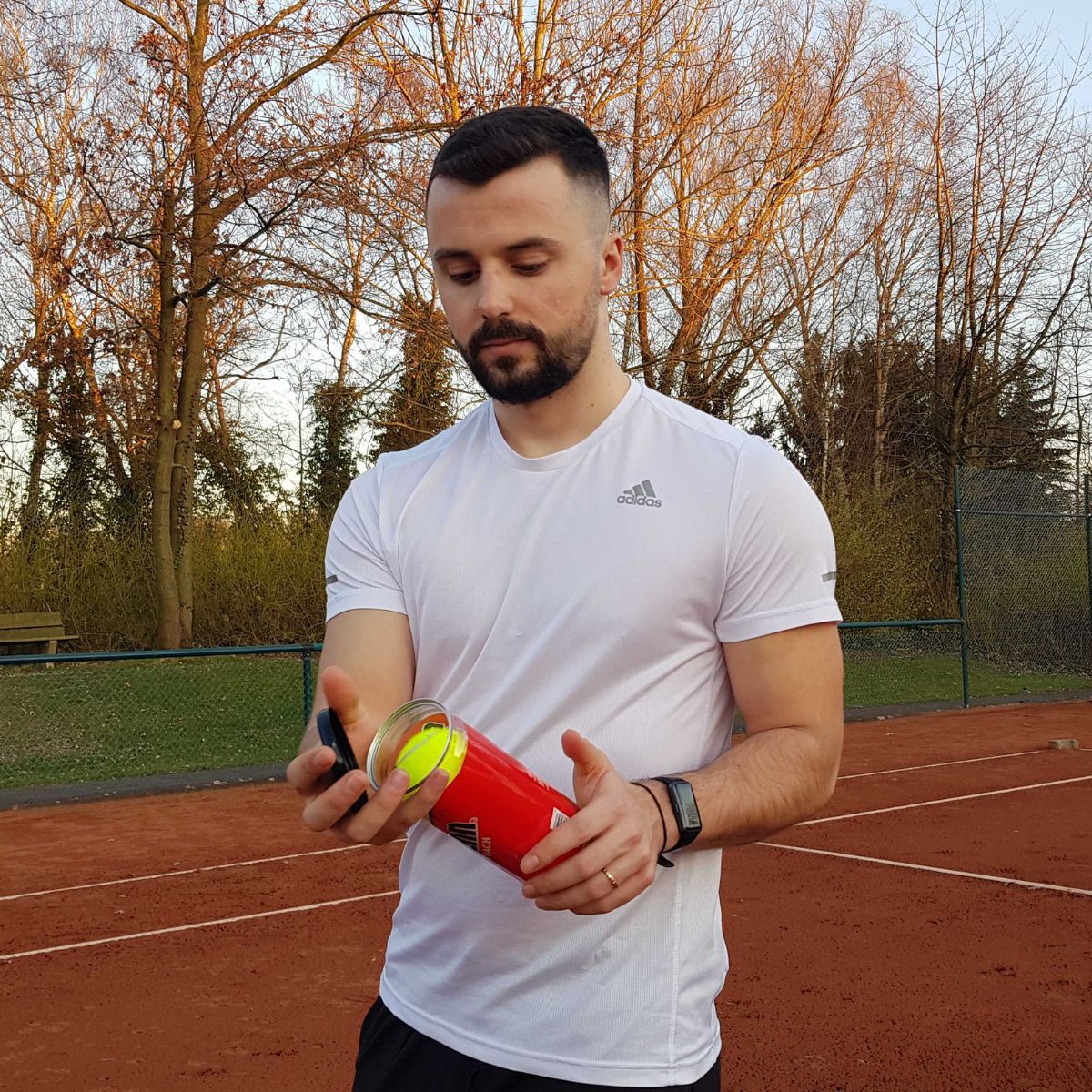- Choosing the right type of string is important for your performance on the court – natural gut, synthetic gut, polyester, multifilament, and kevlar are the most common types.
- The gauge of a string (thickness) impacts durability, spin potential, and feel.
- Tension levels affect power, control, and comfort. It is important to find an appropriate tension level based on skill level and game style.
- Find a qualified stringer to help with racket stringing.
So you bought a new racket and just can’t wait to try it out on the court? Congratulation, but before getting carried away by excitement, you should learn how to choose tennis strings next.
This isn’t the first thing that crosses a beginner’s mind when buying equipment, but not even professional players have the luxury of neglecting it. It would be like picking a car without checking an engine, which would simply not work.
Yeap, tennis strings are that important, so before spending hundreds of dollars on expensive rackets, make sure you know the kind of strings you need because it will directly impact your performance on the court. While picking the right one can be tricky for those who just starting out, in this guide, we’ll explain everything you need to know beforehand. Keep scrolling!
Choose the Right Type of String
Tennis strings can be made from a variety of materials, but the most common types of string options are natural gut polyester and nylon. Here are the main differences between each type.
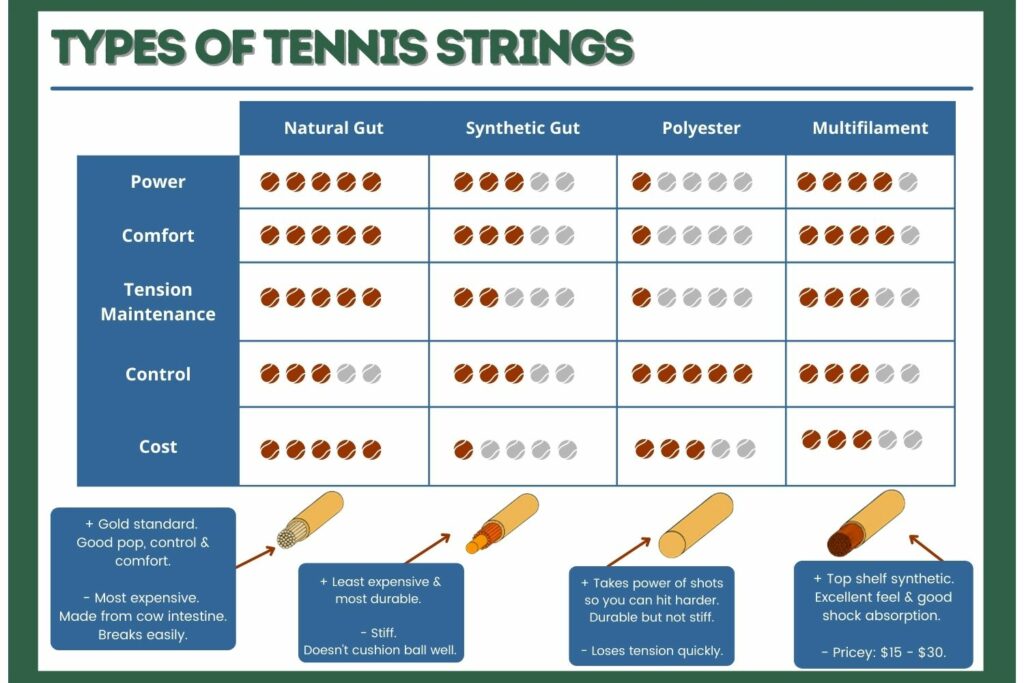
Natural Gut Strings
The first ever strings were made around the 1870s by the famous Babolat brand that used sheep gut. Nowadays, they use cows’ raw intestines membrane, which has proven to perform better and deliver easy playability.
The natural gut is packed with collagen and has a specific molecular structure that makes these strings more powerful and better at holding tension.
The natural gut strings offer an excellent feel and are very comfortable for the arm. They are very expensive, which is only fair because the process of creating a single pair of natural gut strings is complicated and requires hard labor. However, this is a major drawback for most players, that find them far out of their budget.
Natural gut strings break quite fast and are not good at generating spin. While many of your favorite tennis stars use only natural gut for their matches, these drawbacks are reasons enough for you to think twice before making up your mind.
Synthetic Gut
Synthetic gut strings are made primarily of nylon materials. The construction of these strings is very solid and features outer wraps to make them more comfortable and long-lasting. They are a widely popular choice amongst beginners, recreational and intermediate players because synthetic gut strings deliver an overall good performance and come at affordable prices.
They offer satisfying power and spin levels and are very soft and comfortable.
While the playability of these strings is consistent, they don’t have that wow factor in any aspect of the game. Even the best brands offer only average features, while they also noticeably lack feel and have an access string movement. You should consider synthetic gut if you are aiming for a learning experience but not for competitive matches.
Polyester Strings
Polyester strings are arguably the most popular option amongst tennis players. They are made of co-polyester and have monofilament construction. These strings are extremely durable and can deliver incredible spin and control. These features make the polyester string a great option for high intermediate, advanced, and even professional players.
They can also be used for competitive matches as these strings are reliable and deliver high performance on the court.
On the downside, polyester is known for being low-powered and not as good at holding tension as other options. They are quite stiff too, which makes them feel harsh on the arm and shoulder. You should consider polyester strings only if you are a skilled and experienced player that is specifically looking for control-oriented strings while being able to generate speed and power on your own.
If you are currently recovering from injuries or tennis elbow conditions, it’s best to stay away from these strings.
Multifilament Strings
Multifilament strings were specifically created to replicate the natural gut.While it’s not the same experience, the manufacturers have done an amazing job at mimicking the feel and features, which has made multifilament strings very popular.
As the name suggests, these strings are made of multifilament material that is woven together. They deliver a good performance, have high power levels, and do a great job at holding tension.
Multifilament strings offer a plush, soft feeling and are comfortable for the arm. They come in various price points, and most options are affordable and even cheap. However, multifilament strings offer little control and average spin potential at best.
Durability isn’t their strongest point either, especially if you are an advanced player that likes to hit big and go for full, powerful swings. These strings are suitable mostly for beginners or intermediate levels.
They can be a great alternative for those players that are currently recovering from painful injuries or suffer from chronic tennis elbow inflammation.
Kevlar Strings
Kevlar strings are also a widespread option, even though it’s not as popular. They are made of aramid fibers and have a very stiff construction. Kevlar strings are known to be the most durable and long-lasting.
If you are a big hitter and have a history of constantly breaking strings, they might be the answer to your problem. These strings can hold tension very well and offer incredible control. However, the feeling is harsh, and the spin potential disappointing.
Kevlar strings can be the riskier option for tennis players since they are the least comfortable on the arm and can cause serious injuries. The only way to minimize discomfort is to mix kevlar with multifilament or synthetic gut to soften the feel.
Choose the Right Tennis String Gauge
You’ll know how to pick tennis strings if you can successfully determine the gauge level. To put it in simple words, the gauge of a tennis string is its size of it, or more specifically, the thickness rate or the diameter.
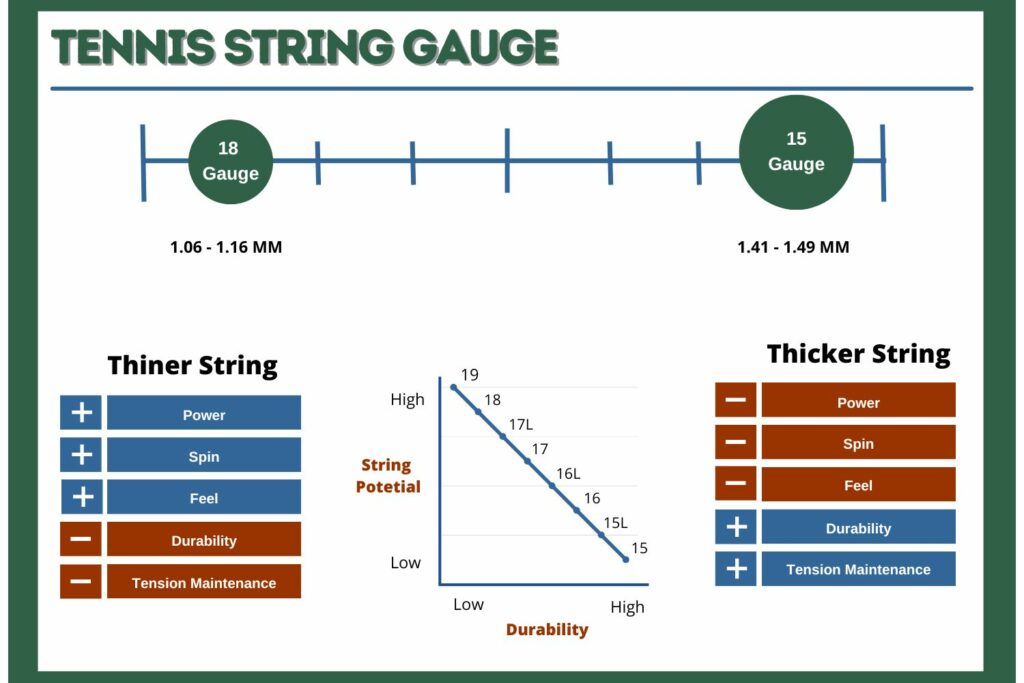
The most common measurements range anywhere from 15, 16, 17, and 18. For the majority of countries across the world, a high gauge signals a thicker string. In the United States is the opposite; the higher the gauge, the thinner the string.
Finding the right gauge level can be a little tricky because it doesn’t have a universal chart you can refer to, and some brands make their own rules. This phenomenon can be confusing even for experienced players, especially for the in-between string gauges; that’s why a millimeter sizing can be more accurate.
Here are the most common gauge measurements and their diameters;
| Measurements | US Gauge | International Gauge |
| 1.65 – 1.80 mm | 13 | 12 |
| 1.50 -1.65 mm | 14 | 11 |
| 1.41 – 1.49 mm | 15 | 9.5 |
| 1.33 – 1.41 mm | 15 L | 9 |
| 1.26 – 1.34 mm | 16 | 8.5 |
| 1.26 – 1.30 mm | 16 L | 8 |
| 1.16 – 124 mm | 17 | 7.5 |
| 1.06 – 1.16 mm | 18 | 7 |
| 0.90 – 1.06 mm | 19 | 4 |
| 0.80 – 0.90 mm | 20 | 3.5 |
Usually, you’ll find this specification cleared out on the string package, which you should always pay close attention to. The gauge level directly impacts the strings’ performance, especially when it comes to three important features;
- Durability: If you are a regular tennis player, you have probably noticed that the racket’s strings tend to create friction at the cross-section. These might be the first signs of your string beginning to notch and break. The thicker strings tend to be more durable and resistant they are. This is the common rule you should go by if you are prioritizing durability, but please keep in mind that other factors like tension maintenance, materials, and construction will also play a role in the longevity of your strings.
- Spin: Thinner strings can generate heavy spin and offer a bigger “bite” of the ball, which helps the player to add more depth to the shots. On the other hand, thicker strings have moderately low to average spin potential.
- Feel: If you are looking for an enhanced feel, then thinner strings can do that for you. Thick strings, on the other hand, have a more muted feeling.
Find the Best Tennis Strings
While there are endless options on the market, picking tennis strings from a well-known brand is a better investment of your money. Usually, the big names of tennis brands are very keen on protecting their image and reputation; that’s why they deliver quality and have the best consumer service.
It would be ideal to try different kinds of strings until you find what kind suits you better if you have the opportunity to do so.
If you aren’t sure what to pick, it would be smarter if you just try the best-rated strings that have great feedback from players. In case you are a beginner, don’t overthink it and just make a choice of what feels right; you’ll have time to experiment with other types, as well.
Here is our take on some of the best tennis strings on the market for different categories;
| Strings | Type |
| Babolat VS Touch | Best natural gut |
| Solinco Hyper-G | Best polyester |
| Gamma TNT2 | Best synthetic gut |
| Wilson NXT | Best multifilament |
| Prince Pro Blend | Best kevlar |
Find an Appropriate Tension
The next step of how to choose a tennis string is to find an appropriate tension level. This is simply the measurement of how tight you pull the strings on the tennis racket’s frame. Strings’ tension range anywhere from 35 – 70 pounds, or 5.88 to 31.75 kilograms.
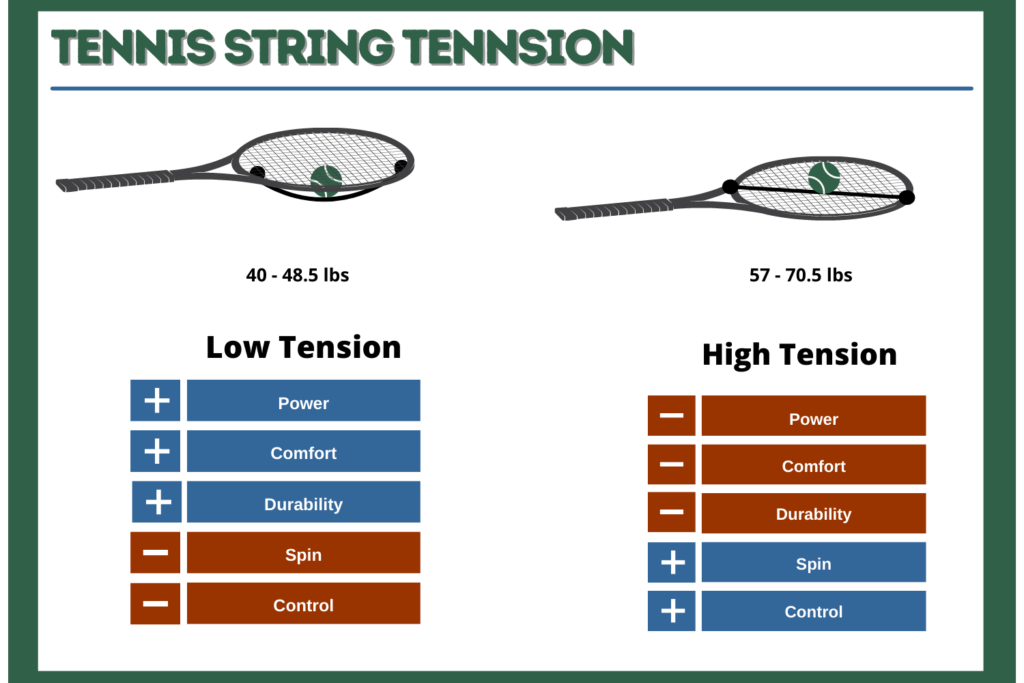
Generally speaking, a lower tension rate will provide more power and comfort while it also increases the sweet spot size. A high tension rate offers more control and spin, but it requires the player to generate their own power.
Because tension affects performance, it would be ideal if you already know what features you need according to your skill levels and game style. However, there is nothing wrong with trying tension levels; just make sure that the difference is not extreme because it will take time for you to get used to and can even cause injuries to your arm and shoulder.
As a beginner, the wide range of tension levels can be confusing; however, there is a simple way to get around it and narrow down your options. Anytime you buy new tennis strings, take a close look at the package. Usually, you’ll find there the instruction for the recommended tension rate. The good tennis rackets also have tension levels recommended written within the frame.
Most of the brands recommend staying between a range of 50 to 60 pounds or 23 to 27 kg, so it’s better to stick to these levels. Split the difference and use these recommendations as a starting point; you can always change the tension rate after a while, based on your needs and preferences on the court.
Find a Stringer
Now that you know everything about how to pick the right tennis strings for your racket, it’s time for the last step; finding a stringer. If you are a beginner or never have tried before to string your own racket, it’s easier to rely on an expert instead of trying to do it yourself.
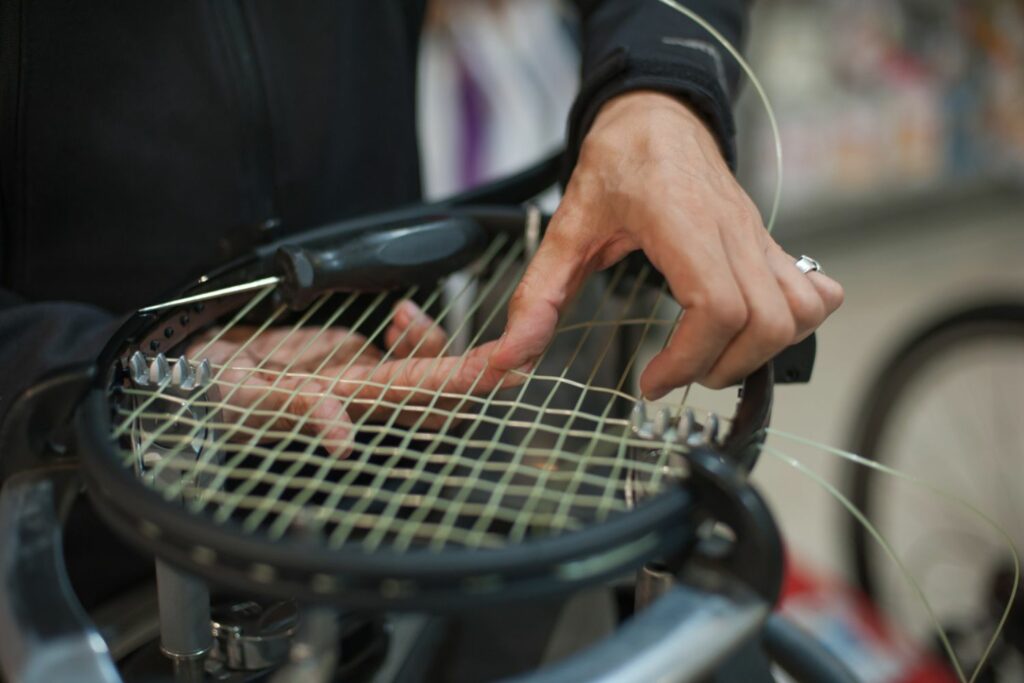
There are many places you can ask for this service, and even consult one last time about the technicalities of your strings of choice, just in case. Obviously, if you have a nearby local tennis club, you should go there first to find a stringer. Sports stores that sell tennis equipment are also a good alternative, where you can find knowledgable people that can string your racket.
However, you have to make sure that the stringer is qualified for this process and not just a seller that is willing to help. Other people you can turn to for help are your local coach, an instructor, or an advanced player who has strung rackets before.
Doing this process yourself should be your last resort, but if you decide to step up to the challenge, make sure to follow tennis string guides strictly, and maybe even watch some youtube videos beforehand so that you can clearly visualize every step of the way.
FAQs
For a bit more information on choosing the right tennis string, keep reading for the answers to some of the most frequently asked questions about this topic.
Q: Should I use 16 or 17 gauge tennis string?
The answer to this question depends on your level of play and what you are looking for in a string. If you are a beginner, it is probably best to use a 16 gauge string because it will be more durable and easier to play with. If you are an advanced player, you might want to try a 17 gauge string because it will offer more spin and feel.
Q: Do thicker tennis strings give more power?
Thicker tennis strings do not necessarily give more power. In fact, they may even reduce power because they can create more resistance against the ball. Thinner strings, on the other hand, can produce more speed and power because there is less resistance against the ball as it moves through the strings.
Q: What gauge tennis string should I use?
The answer to this question is not as straightforward as it might seem. The right tennis string gauge for you depends on a number of factors, such as your playing style, the type of racket you use, and your personal preferences. That being said, we recommend using a string that is between 16 and 18 gauges for all-around performance.
Q: What string pattern do most pros use?
Most pros use a string pattern of 16×19. This string pattern gives the racquet more control and stability while still providing good power and spin potential.
There are a few other popular string patterns that players may use depending on their playing style. A 14×18 string pattern is good for players who want more power and spin, while a 12×20 string pattern is better for players who want more control. However, it’s important to note that each player’s ideal string pattern will vary depending on their individual swing style and preferred playing characteristics.
